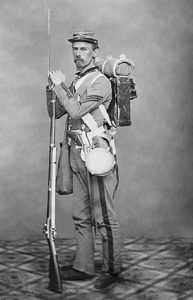The Civil War Soldier’s Load
Technological Innovations

An unknown Union Soldier poses for a photo with a full load. Note the musket, bayonet, and knapsack. Library of Congress.
How to register:
We offer two field trip scheduling options:
- Select a field trip from the Museum’s public event schedule
- Request to schedule a field trip time that meets your group’s schedule
Audience:
All audiences. Content appropriate for Grades 4-12.
Goal:
Through an examination of Soldiers’ Load objects, visitors will learn about the Army’s Civil War military mission and strategy, and Soldiers’ roles in carrying them out. The audience will recognize the load items carried by Civil War Soldiers to illustrate technological change that occurred in the Army during the Civil War.
Program Description:
The Civil War consumed the United States from 1861 to 1865. Tens of thousands of Soldiers endured hardships and challenges to carry out the Army’s military mission to preserve the Union. The items Soldiers carried into the field were invaluable to performing their duty and executing the Army’s mission.
Join a Museum educator to explore the gear, weapons, and personal items that made up a Civil War Soldier’s Load.
Objectives:
At the end of the lesson, participants will be better able to:
- Identify uniforms, weapons, and equipment used by Civil War Soldiers and describe their functions.
- Describe how Soldiers using the objects carried out the U.S. Army’s mission.
- List examples of new technologies used during the Civil War and describe how mission requirements drove innovation.
Guiding Questions:
How did the items that Soldiers carried during the Civil War help carry out the Army’s military mission to preserve the Union?
What technological innovations influenced how Soldiers fought and served?
Curriculum Connections:
Common Core Standards
CCSS.ELA-LITERACY.RH.6-8.2
Determine the central ideas or information of a primary or secondary source; provide an accurate summary of the source distinct from prior knowledge or opinions.
History and Social Science Standards of Learning for Virginia Public Schools
- United States History to 1865
- USI.9 The student will apply history and social science skills to understand the cause, major events, and effects of the Civil War by
- a) describing how slavery and its expansion was the primary cause of the cultural, economic, and constitutional issues that divided the nation and led to the secession of southern states;
- F) analyzing the effects of the war from various perspectives of Union and Confederate soldiers, Indigenous peoples, women, European Americans, and enslaved and free Blacks during the war including, but not limited to Clara Barton, John Brown, Robert Smalls, Harriet Tubman, Elizabeth Van Lew, and Mary Bowser.
- USI.9 The student will apply history and social science skills to understand the cause, major events, and effects of the Civil War by
- Virginia and United States History
- VUS.9 The student will apply history and social science skills to analyze the major turning points of the Civil War and Reconstruction eras by
- evaluating and explaining the impact of the war on Americans, with emphasis on Virginians, enslaved and free Blacks, the common soldier, and the home front;
- VUS.9 The student will apply history and social science skills to analyze the major turning points of the Civil War and Reconstruction eras by
Your message has been submitted.
